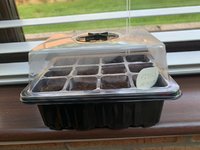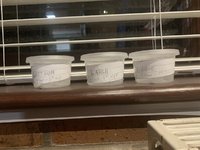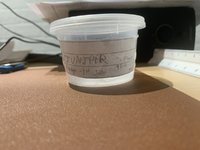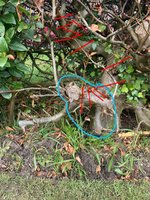ForeverRaynning
Sapling
Hello everyone!
So I’m completely new to this. Never had any real interest in bonsai before but my grandad gave me a bonsai growing kit he’d recieved the other year (he’s 90 and has an absolutely amazing green thumb with veg and flowers, but said he won’t get much use out of the kit at his age). I’ve one houseplant that I’ve kept alive for over a year and thats about it.
I decided to follow the instructions from sheffields in terms of scarification, stratification and sowing. A lot of the kit reviews mention only having success with one set of seeds (pinus halipensis) so I went looking for more reputable/detailed instructions. This may have been a mistake, I’m not sure.
So far I have planted the pines after a 24h soak in water. They are in a seed tray with a humidity dome in my south facing conservatory (but the blinds have been down so not been getting that much sun, opening them a bit yesterday incase the extra heat from the sun may help). They have been there for a little over 2 weeks and nothing has come up yet. I watered them yesterday, first time, the dome always has condensation so I assume the soil was still wet but watered anyway just to be safe as I was a but worried I should have been watering them (I did bottom watering as heard thats better for the roots and to not disturb the seeds). Also just opened the vents on the dome today incase some air is needed. The temp will drop in there quite a bit overnights but I figured trees grow outside normally anyway and would go through temperature fluctuations, but I know germination is usually done with heat mats or warm areas, the conservatory just gets the most sun.
The other species are in the stratification stage in tubs with wet paper towel, the larch, redbud and sweetgum are in the fridge, the junipers or just on my desk in my room for warm stratification before they go in for cold in a few months. When i open the tubs, the towel is still wet, theres no puddles of water, but the tubs do smell. Is this ok or have I rotted all my seeds and failed before I’ve even started? I struggle to know what ‘moist/damp, not wet’ actually means/feels like.
Basically just need advice/support/encouragement on if I’m doing things even remotely correctly (and maybe some guidance if I’m not). Getting a bit worried I’ve cocked it all up. I’m autistic and struggle socially so I’d appreciate a gentle approach/tone as I do get discouraged/upset easily, especially if I have done something wrong.
I know it’ll be years before they can even become bonsai, but I’m ok with that. This is more of an experiment to see if I can even get anything to grow at the moment. At least I have plenty of time to learn bonsai techniques and things. I’m quite enamoured with the thought of my own little trees, even just getting tiny seedlings. I know a lot of people start with already established trees but I think that would be a bit much for me right now.
Happy to be here! I’ve added pictures of the little tubs and of the setup for the pines to show you all.
So I’m completely new to this. Never had any real interest in bonsai before but my grandad gave me a bonsai growing kit he’d recieved the other year (he’s 90 and has an absolutely amazing green thumb with veg and flowers, but said he won’t get much use out of the kit at his age). I’ve one houseplant that I’ve kept alive for over a year and thats about it.
I decided to follow the instructions from sheffields in terms of scarification, stratification and sowing. A lot of the kit reviews mention only having success with one set of seeds (pinus halipensis) so I went looking for more reputable/detailed instructions. This may have been a mistake, I’m not sure.
So far I have planted the pines after a 24h soak in water. They are in a seed tray with a humidity dome in my south facing conservatory (but the blinds have been down so not been getting that much sun, opening them a bit yesterday incase the extra heat from the sun may help). They have been there for a little over 2 weeks and nothing has come up yet. I watered them yesterday, first time, the dome always has condensation so I assume the soil was still wet but watered anyway just to be safe as I was a but worried I should have been watering them (I did bottom watering as heard thats better for the roots and to not disturb the seeds). Also just opened the vents on the dome today incase some air is needed. The temp will drop in there quite a bit overnights but I figured trees grow outside normally anyway and would go through temperature fluctuations, but I know germination is usually done with heat mats or warm areas, the conservatory just gets the most sun.
The other species are in the stratification stage in tubs with wet paper towel, the larch, redbud and sweetgum are in the fridge, the junipers or just on my desk in my room for warm stratification before they go in for cold in a few months. When i open the tubs, the towel is still wet, theres no puddles of water, but the tubs do smell. Is this ok or have I rotted all my seeds and failed before I’ve even started? I struggle to know what ‘moist/damp, not wet’ actually means/feels like.
Basically just need advice/support/encouragement on if I’m doing things even remotely correctly (and maybe some guidance if I’m not). Getting a bit worried I’ve cocked it all up. I’m autistic and struggle socially so I’d appreciate a gentle approach/tone as I do get discouraged/upset easily, especially if I have done something wrong.
I know it’ll be years before they can even become bonsai, but I’m ok with that. This is more of an experiment to see if I can even get anything to grow at the moment. At least I have plenty of time to learn bonsai techniques and things. I’m quite enamoured with the thought of my own little trees, even just getting tiny seedlings. I know a lot of people start with already established trees but I think that would be a bit much for me right now.
Happy to be here! I’ve added pictures of the little tubs and of the setup for the pines to show you all.




